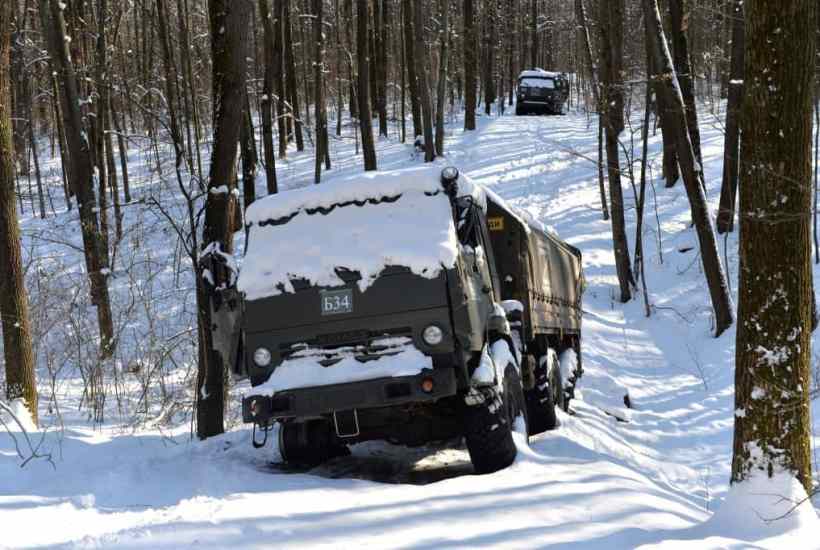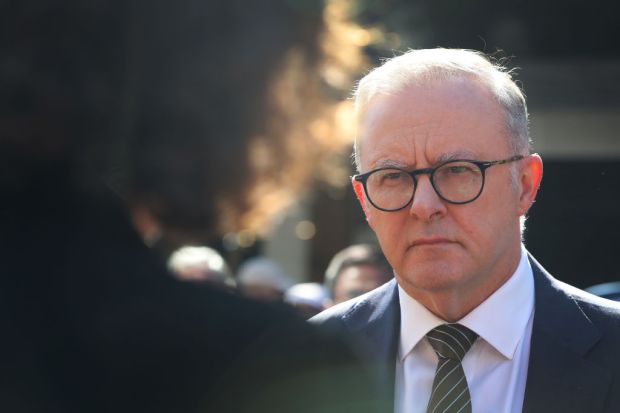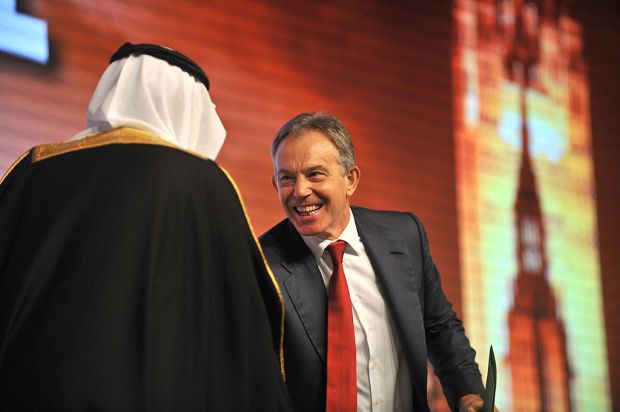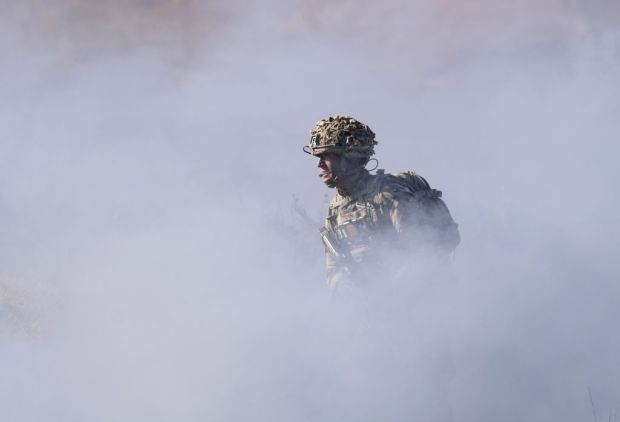As the Russian invasion enters its fourth week it is clear that its forces are running out of momentum, although they continue to make limited territorial gains in the south and east of Ukraine.
Having been denied a quick victory over Ukraine itself, Putin now needs to force the Ukrainian government to accept a ceasefire agreement that largely freezes the frontlines and allows him to claim a victory domestically. His strategy now appears to be to cut off the Ukrainian forces fighting a desperate battle to hold the line in Donbas in the east against combined Russian and separatist Donetsk and Luhansk forces from the rest of Ukraine, and to concentrate more firepower on the besieged cities of Mariupol in the south and Kharkiv, Sumy and Chernihiv in the north. If Russian forces can achieve the isolation and potential destruction of what was the Ukrainian Joint Forces Operation (JFO) in Donbas, Putin could claim that the Russian invasion had ‘saved’ separatist Donetsk and Luhansk.

The past week has seen more Russian progress in eastern Ukraine than anywhere else in the country. The Russian army initially attempted to advance northwards from the occupied city (and railhead) of Melitopol towards Dnipro via Zaporizhia. However, heavy resistance at Vasylivka and other small towns en route have so far prevented it from even reaching Zaporizhia. A Russian attempt to push southwards from Kharkiv in the north towards Dnipro was also unsuccessful. In fact, Russian forces have failed to completely cut Kharkiv off from the rest of Ukraine despite its close proximity to the Russian border.
With an advance on Dnipro having failed to make much headway in the north or south, Russian forces have instead started a less ambitious push north from around Mariupol itself, in conjunction with renewed offensive activity from the Donetsk People’s Republic and Russian forces south of Donetsk. This has led to particularly fierce fighting at Volnovakha as Ukrainian forces attempt to hold their positions on their southern flank. It has also increased the gap between the besieged and increasingly pulverised city of Mariupol and any would-be relieving forces. At the same time, Russian forces around Kharkiv have pushed southwards in the direction of Barvinkove. They have had one notable success on this axis in recent days: taking the town of Izyum. As a result, the Ukrainian forces concentrated around Kramatorsk are potentially in danger of encirclement in the coming week.
Despite continuing to make slow progress in the east of Ukraine, however, Russian forces elsewhere have failed to generate any offensive momentum in the past week. In the south west, where Russia had significant success in the first week of the war, the Ukrainian army has undertaken a successful counteroffensive which has relieved the pressure on the south western city of Mykolaiv. Mykolaiv had been the site of fierce fighting for over two weeks, and losses on both sides have been high.
But despite allocating significant resources to the attempt to encircle Mykolaiv and potentially drive westwards to threaten Odessa, Russian forces have been stopped and driven back. The successful Ukrainian counterattack at Mykolaiv also threatens the flank of Russian forces attempting to advance north along the western bank of the Dnieper river towards Kryvyi Rih, since their supply lines run through Kherson.
In the north west, Russian forces have been unable to make significant progress towards encircling Kyiv and supply lines into the city from the West remain open. Furthermore, they have been unable to overcome Ukrainian forces defending the small city of Sumy in the north east, despite encircling it in the first days of the invasion and having committed significant forces to try and capture it.
Ukrainian forces also continue to hold out in the north eastern city of Chernihiv despite being more or less cut off from resupply or relief. The main Russian thrusts which have bypassed Sumy and Kharkiv to try and encircle Kyiv from the east have also failed to advance beyond the suburbs of Brovary and Boryspil. Ukrainian light infantry teams with anti-tank weapons are continuing to effectively harass and, in some cases, destroy Russian reinforcement and resupply columns. This is delaying Russian attempts to build up sufficient forces near Kyiv to complete the encirclement of the capital, and increasing their losses among already depleted logistics support units. Given that Mariupol continues to hold out despite being surrounded, bombarded and starved without supplies for three weeks, and Russian forces have been unable to take Sumy, Chernihiv or Kharkiv, it seems highly unlikely at this point that Russia can muster sufficient forces to attempt a serious assault on Kyiv in the coming weeks.

In return for its modest territorial gains, some of which are now in danger of being reversed, the Russian military has suffered devastating losses. While accurate figures are impossible to obtain, the US military believes that over 10 per cent of the roughly 190,000 troops which Russia has committed to the invasion are no longer available to them. Visually confirmed vehicle and heavy weapon losses are now over 1,500, including over 240 main battle tanks, 460 armoured fighting vehicles and armoured personnel carriers, 34 helicopters, 35 surface-to-air missile systems and 500 trucks and other soft-skinned vehicles. Ukrainian losses are much less clear, but are undoubtedly much higher than many believe – since Ukraine has been highly effective in dominating the information space to enhance public awareness of Russian losses while minimising the visibility of its own losses. Russian use of heavy firepower throughout Ukraine, but in particular in the south and eastern theatres, will have inevitably inflicted serious losses on the Ukrainian military in addition to civilians as a result of the bombardment of besieged cities.
Ukraine has mobilised hundreds of thousands of reservists and civilian volunteers, and is receiving huge supplies of weaponry and other key aid to equip these new forces in the relatively secure western half of the country. However, it is impossible to provide sufficient training to new volunteer forces to make them reliably effective against Russian forces in only a few weeks. As a result, Ukraine has an ever-increasing advantage over the Russian invasion forces in sheer numbers, but committing these newly mobilised forces to operations en masse will result in extremely heavy casualties and limited effectiveness due to lack of training and experience.
But the longer this war continues, the worse position Russian forces will find themselves in and the larger and more capable the Ukrainian reserve and volunteer forces will become. If Ukraine can sustain the current pace of combat without overcommitting its inexperienced new forces, it can deny the overstretched Russian forces an opportunity to consolidate their current positions and may be able to force them to retreat in other areas as their supply lines and staging areas become indefensible. However, if Russia manages to force a ceasefire that leaves its forces in place, then it is likely to use that pause to reinforce its frontlines, get logistics support to its beleaguered units and renew its ability to sustain offensive momentum.
Got something to add? Join the discussion and comment below.
Get 10 issues for just $10
Subscribe to The Spectator Australia today for the next 10 magazine issues, plus full online access, for just $10.



















Comments
Don't miss out
Join the conversation with other Spectator Australia readers. Subscribe to leave a comment.
SUBSCRIBEAlready a subscriber? Log in